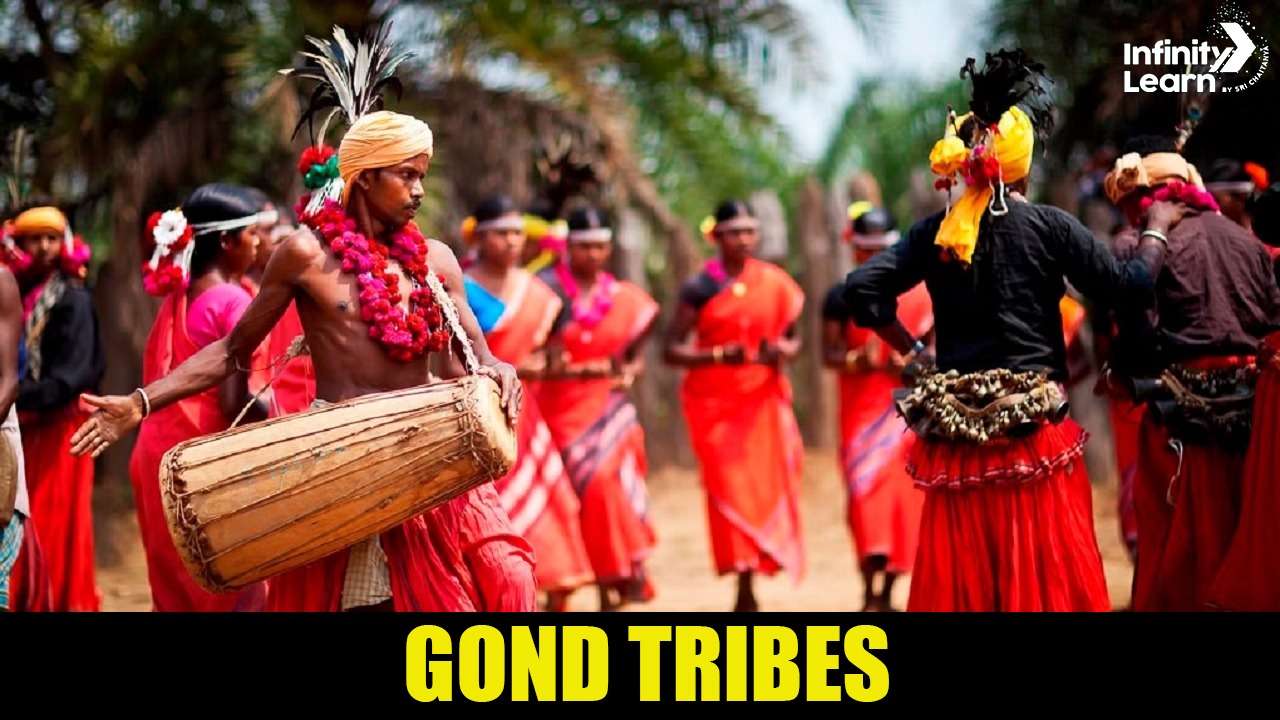Table of Contents
The Gond tribes are indigenous people primarily found in central India, known for their rich culture and traditions. They traditionally inhabit forests and hilly regions, maintaining a close connection with nature. Agriculture and forest resources play crucial roles in their livelihoods.
Gonds have a vibrant oral tradition, passing down myths, stories, and songs through generations. Their art, including intricate tattoos and paintings, reflects their spiritual beliefs and daily life. They celebrate festivals like Diwali, Holi, and Bhagoria with enthusiasm, showcasing their cultural heritage.
Socially, Gonds are organized into clans, each headed by a chief who helps resolve disputes and guide community affairs. They practice animism, believing in spirits inhabiting natural elements. Despite facing challenges like displacement and lack of resources, Gond communities strive to preserve their identity and traditions, contributing to India’s diverse cultural landscape.

Different Gond Tribes
Gonds are subdivided into four tribes:
- Raj Gonds
- Dhurve Gonds
- Madia Gonds
- Khatulwar Gond
Also Check:
Tribes of Nagaland and Their Population
Nagaland, a northeastern state of India, is home to several tribes, each with its own unique culture and traditions. Some prominent tribes include the Ao, Angami, Sema, Lotha, and Konyak tribes. These tribes have distinct languages, dress styles, and festivals that reflect their rich heritage.
The Ao tribe is one of the largest, primarily found in the Mokokchung district. The Angami tribe inhabits the Kohima district and is known for their vibrant shawls and skilled craftsmanship. The Sema tribe resides in the Zunheboto district and is recognized for their agricultural practices.
The Lotha tribe, based in Wokha district, is famous for their colorful dances and traditional attire. Lastly, the Konyak tribe, located in the Mon district, is renowned for their intricate tattoos and headhunting history.
While exact population figures vary, these tribes play a significant role in preserving Nagaland’s cultural diversity and contribute to its vibrant social fabric.
Gond Tribes Culture
The Gond tribe’s culture focused on old-fashioned home business like painting floors, making pots, and weaving baskets. Gond men also do stonework and woodwork. They carve words on pillars, make memorials, and decorate palaces and religious spots.
Gond Tribes History
The Gond tribe is known for its rich culture, deeply rooted in traditions and beliefs. They primarily live in central India, in states like Madhya Pradesh, Chhattisgarh, Maharashtra, and Odisha. Here are some aspects of Gond tribe culture explained in simple words:
- Art and Craft: Gonds are famous for their vibrant art forms, especially their intricate paintings on walls and floors called “Gond art.” These artworks often depict nature, animals, and mythological stories.
- Music and Dance: Music and dance are integral to Gond culture. Their traditional songs and dances celebrate occasions like harvests and festivals, showcasing their unity and joy.
- Beliefs and Rituals: Gonds have a deep spiritual connection with nature and worship a variety of gods and goddesses. They perform rituals to seek blessings for prosperity and well-being.
- Livelihood: Traditionally, Gonds are farmers and forest dwellers. They practice agriculture and gather forest produce for their livelihoods.
- Social Structure: Gond society is organized around clans, each with its own customs and traditions. Elders play a significant role in decision-making and preserving cultural heritage.
FAQs on Gond Tribes
Where is the Gond tribe located?
The Gond tribe is primarily located in central India, across states like Madhya Pradesh, Chhattisgarh, Maharashtra, and parts of Odisha, Andhra Pradesh, and Telangana.
What are Gonds famous for?
Gonds are known for their vibrant art, especially their intricate paintings and tribal art forms, which reflect their rich cultural heritage.
How many types of Gond tribe are there?
There are four main types of Gond tribes: Raj Gonds, Madia Gonds, Koya Gonds, and Dorla Gonds.
What is Gonds in history?
Gonds have a long history in India, known for their resistance against Mughal and British rule, and their traditional governance structures.
What is the culture of Gond tribe?
The Gond tribe has a rich cultural heritage, including music, dance, festivals like Bhagoria and Karma, and their unique Gondi language.
What is the lifestyle of Gond?
The Gonds traditionally practice agriculture, hunting, and gathering. They live in close-knit communities and have strong ties to their land and forests.
What do Gonds tribes wear?
Gonds traditionally wear simple attire, with men often wearing dhotis and shirts, while women wear sarees or lehengas with traditional jewelry.
In which state Gond tribe is found in India?
The Gond tribe is found predominantly in the states of Madhya Pradesh, Chhattisgarh, Maharashtra, and parts of Odisha, Andhra Pradesh, and Telangana.
What is the origin of Gond?
The origin of the Gond tribe is believed to be ancient, with roots in the Gondwana region of central India.
Which is the largest tribe in India?
The Gond tribe is one of the largest tribes in India, known for their widespread presence across central and eastern India.
Who is Gond by caste?
Gond is a prominent tribal community in India, known for their unique cultural practices, art, and heritage. The Gonds are Rajputs but of Scheduled Tribes.






